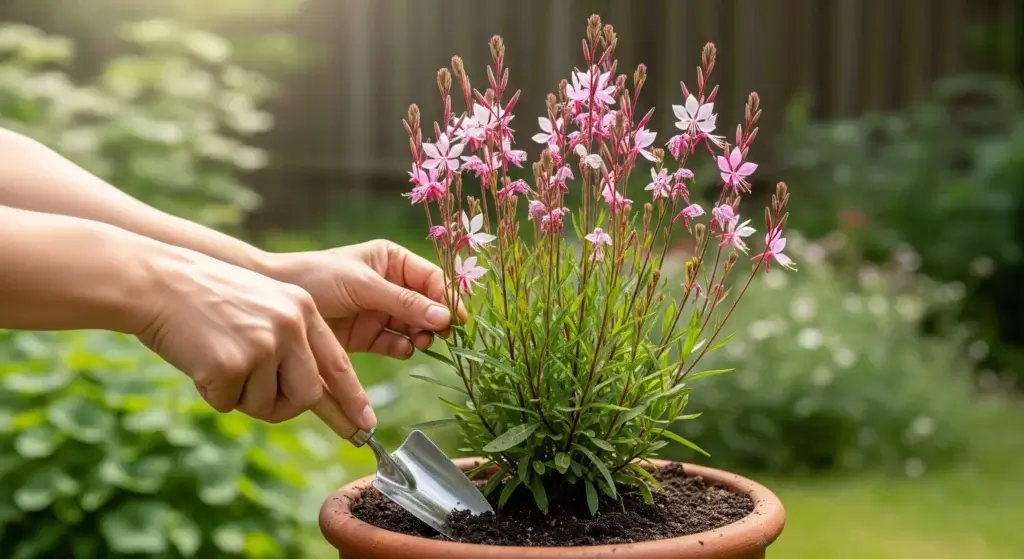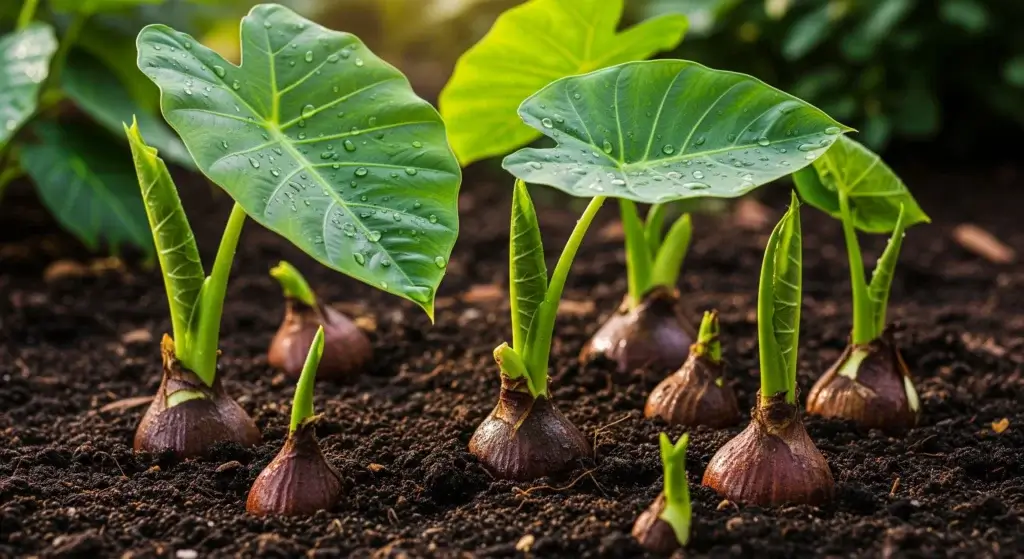
Yellow onion leaves can stress out any gardener.
While a little yellowing is normal as onions grow, too much too soon usually means something’s wrong.
It could be pests, disease, water issues, or poor soil.
This quick guide breaks down what causes yellow leaves and what you can do to fix it—so your onions stay healthy and your harvest stays strong.
Understanding Normal vs. Problematic Yellowing
Knowing the difference between normal and worrisome yellowing is key if you’re growing onions.
A little yellow on the outer leaves is totally normal when the bulbs are close to harvest—usually in the last 2–3 weeks.
No need to panic there.
But if you’re seeing yellow leaves early in the season, across a bunch of plants, or spreading fast, that’s a red flag.
That kind of yellowing usually means the plants are stressed—could be pests, poor drainage, not enough nutrients, or something else.
And if you don’t deal with it, it can mess with your yield.
Top 8 Causes of Yellow Onion leaves
1. Overwatering and poor drainage
This is hands-down the most common issue.
Onions like steady moisture but hate sitting in soggy soil.
If the roots stay wet too long, they can’t breathe or take up nutrients.
What to look for:
- Yellowing starts from the lower leaves
- Bulbs feel soft or mushy
- You see mold or mushrooms near the base
- Soil stays wet for more than a day after watering
Fix it:
Let the top layer of soil dry out before watering again.
Water deeply once or twice a week instead of a little every day. If drainage’s bad, mix in compost or grow in raised beds.
2. Nutrient deficiencies
Onions are hungry plants, especially for nitrogen.
When they’re short on food, the older leaves usually show it first.
Signs of nitrogen deficiency:
- Lower leaves turn yellow
- Plants look pale and weak
- Bulbs stay small
Fix it:
Use a balanced fertilizer like 10-10-10 every few weeks.
If you’re going organic, blood meal, compost, or fish emulsion all work.
If you’re not sure what’s missing, get a soil test—it’ll save you guessing.

3. Fungal diseases
Fungi love cool, damp conditions—and onions are easy targets.
Common ones are downy mildew and purple blotch.
Downy mildew:
- Yellow patches with fuzzy gray growth
- Leaves may curl or twist
- Spreads fast in damp weather
Purple blotch:
- Small spots that go from yellow to purple
- Yellow rings around the spots
- Can move from leaves to bulbs
Fix it:
Give plants space to breathe.
Water in the morning so leaves dry out by night.
Pull sick plants and don’t compost them.
Rotate your beds—don’t grow onions in the same spot every year.
If needed, use an organic fungicide early in the season.
4. Pest Infestations
Tiny bugs can cause big problems.
Thrips and onion maggots are the usual suspects.
They damage the leaves or carry diseases that cause yellowing.
Thrips:
- Silvery streaks that turn yellow
- Tiny black dots (bug poop)
- Curled or twisted leaves
Onion maggots:
- One plant turns yellow, wilts, then dies
- Dig around—if you see little white larvae, that’s them
Fix it:
Use row covers early in the season to block bugs.
Add beneficial nematodes to the soil to tackle maggots. For thrips, try neem oil or bring in ladybugs.
If a plant is badly infested, pull it and toss it far from your garden.
5. Soil pH imbalances
Even if you’re feeding your onions right, if the pH is wrong, they can’t take up what they need.
Onions like soil that’s a little acidic to neutral—somewhere between 6.0 and 7.0.
What to watch for:
- Leaves still yellow even after you fertilize
- Plants look stunted or just don’t take off
- Other crops nearby acting weird too
Fix it:
Grab a pH test kit or meter—don’t guess.
If soil’s too acidic, add garden lime (do this weeks before planting).
If it’s too alkaline, mix in sulfur or peat moss.
Compost helps balance things out too.
6. Temperature stress
Onions don’t love drama. Big shifts in weather—hot days, cold nights—can stress them out.
They like cool weather to grow leaves and warm weather later to bulk up bulbs.
Clues it’s temperature stress:
- Yellowing matches up with a cold snap or heat wave
- Other plants look off too
- Leaves perk up when the weather evens out
Fix it:
Use shade cloth when it’s blazing hot. Cover beds with row fabric if a cold front’s coming.
Long-term, choose varieties bred for your region—they’ll handle local weather better.
7. Herbicide damage
Onions are sensitive.
Even a little herbicide spray from a neighbor’s yard or leftover chemicals in compost can cause yellowing.
What it looks like:
- Yellowing that doesn’t look like pest or disease patterns
- Twisted or weirdly shaped leaves
- Symptoms show up right after nearby spraying
Fix it:
Don’t spray anything near your onion bed.
If there’s already damage, flush the soil with water.
Some folks use activated charcoal to bind leftover chemicals, but results can vary.
If things are really bad, you might need to pull plants and replant in clean soil.
8. Natural Maturation Process
This one’s totally normal.
When onions start to mature, the tops yellow and flop over.
That’s your cue that they’re almost done.
How to tell it’s natural:
- Yellowing starts with outer leaves
- Bulbs are swelling and firming up
- Pretty much the whole bed’s doing it at the same time
Fix it:
No fix needed. Let the tops fall over naturally.
Once about half to three-quarters of the leaves have yellowed, you’re good to start drying and curing your onions.

Diagnostic Steps for Yellow Onion Leaves
Here’s how to break it down when your onion leaves start yellowing—no fluff, just what works in real gardens:
Step 1: Examine the pattern
Start with where the yellowing shows up.
If it’s the bottom leaves turning first and moving up, you’re probably dealing with water or nutrient issues.
If it’s random—like scattered patches—it might be pests or disease.
Tip: Make a quick sketch of your bed or snap a photo. Helps you spot patterns you might miss just by looking.
Step 2: Check soil conditions
Don’t just poke the top. Go down 2–3 inches.
Is it soggy? Dry? Are the roots slimy or discolored? That’s root rot or waterlogging.
If you see tunnels or tiny bugs near the base, that’s a pest problem.
Quick check: Grab a handful of soil. If water drips out or it stays clumped like clay, it’s holding too much moisture.
Step 3: Inspect for pests
Thrips are tiny and hide in leaf folds. Onion maggots live down in the soil. Get up close—check for streaks, curling, black specks (bug poop), or soft spots near the bulb.
What helps: A magnifying lens. Sounds extra, but it makes a big difference when spotting thrips or eggs.
Step 4: Consider recent weather
Ask yourself: Has it been really hot? Cold? Wet for days? Onions don’t handle sudden swings well.
A random yellow patch after a hot spell might just be heat stress, not disease.
Pro tip: Keep a short garden log. Just a few notes on temps, rain, and treatments can save you guesswork later.
Step 5: Test soil if necessary
If nothing obvious shows up, test the pH and nutrients.
Sometimes the soil looks fine but is locking out nitrogen or other minerals because the pH is off.
Use: A basic soil test kit is good enough. Labs are more detailed but slower. You can always retest in a few weeks if things don’t improve.

Prevention Strategies for Healthy Onion Growth
Soil preparation
If your soil’s not draining well, you’re already at a disadvantage.
Onions hate wet feet. Mix in compost or aged manure before planting.
Don’t skip the pH check—shoot for 6.0–7.0. If you don’t test, you’re guessing.
Proper planting techniques
Give onions space. Crowded beds lead to poor airflow and disease.
Plant at the right depth—just deep enough to cover the roots but leave the neck above ground.
Check your local frost dates and use varieties that actually grow well in your zone.
Watering best practices
Don’t water every day. Onions want deep watering once or twice a week, depending on heat and soil.
Let the top inch dry out before watering again.
Use drip lines or soaker hoses so you’re not soaking the leaves—wet foliage invites fungus.
Fertilization schedule
Start with a balanced fertilizer at planting.
Once the tops start growing, switch to nitrogen-heavy feed every few weeks.
As soon as you see bulbs forming, back off the nitrogen and add more phosphorus instead.
Monitoring and maintenance
Walk your garden once a week. Look for yellowing, pests, wilting, or weird growth.
Pull weeds early—they steal nutrients and shelter bugs.
Clean up dead leaves and trim diseased parts right away.

When to Seek Professional Help
If you’ve adjusted water, fed the soil, checked for pests—and nothing’s working—it’s time to get help.
Call your local extension office or a nearby nursery with actual growing experience.
If you’re dealing with multiple crops showing issues, or suspect bad compost or chemicals, ask about a full soil and tissue test.
Conclusion
Yellow onion leaves aren’t the end of the world.
Most of the time, it’s something fixable—like too much water, not enough nutrients, or a fungal issue.
Catch it early, and you’ve got a good shot at turning things around.
Stick to the basics: prep your soil, water smart, feed when needed, and check your plants often.
Keep notes—it helps you learn what works and what doesn’t in your garden.
Even if it’s frustrating, every problem teaches you something. That’s just part of growing.



